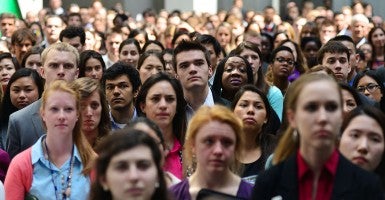Economists are scratching their heads trying to figure out a puzzle in this recovery: Why are young people not working? People retiring at age 60 or even 55 in a weak economy is easy to understand. But at 25?
The percentage of adult Americans who are working or looking for work now stands at 62.8%, a 36-year low and down more than 3 percentage points since late 2007, according to the Labor Department’s May employment report.
This is fairly well-known. What isn’t so well-known is that a major reason for the decline is that fewer and fewer young people are holding jobs. This exit from the workforce by the young is counter to the conventional wisdom or the Obama administration’s official line.
The White House claims the workforce is contracting because more baby boomers are retiring. There’s some truth to that. About 10,000 boomers retire every day of the workweek, so that’s clearly depressing the labor market. Since 2009, 7 million Americans have reached official retirement age. The problem will get worse in the years to come as nearly 80 million boomers hit age 65.
But that trend tells only part of the story. The chart above shows the real problem: The largest decline in workforce participation has been those under 25.
Idle Youth
The percentage of young Americans earning a paycheck or looking for work has fallen by 4 percentage points over the course of the recovery, and those between 16 and 25 have experienced the largest decline.
Those over 65, by the way, are more likely to be working today than five years ago. This shift has cushioned the blow of young people not working.
Why is this trend so troubling? Studies show that teens who start working at a job at a young age have higher earnings later in life. One study found that those who work as teenagers have earnings that are about 10% higher at age 27 than those who did not work.
“When we hold young Americans out of jobs,” explains Michael Saltsman of the Employment Policies Institute, “that makes it more difficult for them to get higher-paying jobs later.”
The federal minimum-wage hikes that started in 2007 didn’t help. Teens were priced out of the job market. The overall teen jobless rate skyrocketed. For black males, it topped 40%.
The teen unemployment rate remains at 19.2% — even with the participation rate down sharply — so it would be hard to imagine a worse time to raise the minimum wage again.
Minimum Wage Impact
Saltsman’s research shows that a 10% rise in the minimum wage could mean a 2% or 3% decline in young Americans working. Seattle is raising its minimum wage to $15 an hour. A $10.10 federal minimum wage is being pushed by the White House. The current minimum wage is $7.25.
“When wages are held artificially high,” says Ohio University economics professor Richard Vedder, “jobs are a lot more scarce. Unemployment is negatively associated with the wage rate.”
High teen unemployment is a big problem in Europe, where wage floors are very high. In nations such as France and Spain, the young delay their entry into the workforce until their mid- or even late 20s. These workers’ wages rarely catch up to those who start working earlier. Europe has traditionally had a much smaller share of young adults in jobs.
“Where have the workers been going in the U.S.?” asks Louis Woodhill, an economist in Houston. “They have been fleeing into the arms of the welfare state.” Since 2007, 2 million more Americans have started receiving Social Security disability payments, and food-stamp rolls have increased by 20 million. This has substituted for jobs.
Student Loans
One possible reason that the young are staying away from the labor force is student loans. Since 2007, student loans have risen by more than $500 billion, a subsidy that may be giving college-age students an incentive to take aid instead of look for work to become financially self-sufficient and acquire marketable skills.
We do no favors to the young by teaching them that they can consume or have a good time without first earning the money they spend. The decline in young workers couldn’t come at a worse time. At the other end of the spectrum, as the 80 million boomers move swiftly out of the workforce in the decade ahead, who will support them? Mick Jagger isn’t going to be playing forever.
Originally posted on Investors.com.





























